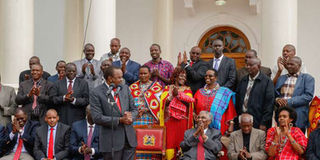Former Cabinet minister had great sway on the Maasai voters

President Uhuru Kenyatta with leaders from Narok and Laikipia Counties led by former Cabinet Minister William Ole Ntimama (seated 3rd from right). Mr Ntimama died on September 1, 2016. PHOTO | PSCU
What you need to know:
- He rose to notoriety when he challenged long-serving Cabinet Minister Justus ole Tipis for the Narok North parliamentary seat in 1988, with unashamed appeal to Maasai nationalism, depicting his old rival as less than pure-blood member of the community.
- The Enoosupukia episode was part of the land and ethnic clashes across the Rift Valley engineered by denizens of the Moi regime in the early 1990s as their response to the campaign for a multi-party political system.
- Ntimama was also noted as a keen conservationist, applying a fierce approach to protection of the Mau Forest against human encroachment, which often brought him into conflict with his Kalenjin political allies.
The laugh always came from deep down in the belly, reverberating across the room and rattling the windows. He always came across as charming, intelligent, and well-read; a great subject for interviews, where he would readily respond to the most hostile queries with ease, a sense of humour and that familiar twinkle in his eye.
That was the appealing and lovable side of the great enigma. Then there was the other one, the war-monger, demagogue and instigator of ethnic pogroms.
As the last of Kenya’s great ethnic chieftains took his final bow, William ole Ntimama left a lasting legacy as great defender of his beloved Maasai people, but also the dark side as unapologetic architect of ethnic clashes that targeted Kikuyu, Kisii, Kalenjin and other communities he accused of encroaching onto Maasailand.
Ntimama is many ways was a contradiction in terms, frequently switching positions and alliances.
He rose to notoriety when he challenged long-serving Cabinet Minister Justus ole Tipis for the Narok North parliamentary seat in 1988, with unashamed appeal to Maasai nationalism, depicting his old rival as less than pure-blood member of the community.
At public rallies he openly dismissed Tipis and his supporters as ‘bow-legged, stained-teeth’ Kikuyus, promising to expel the immigrants from central Kenya and reclaim the land for the Maasai.
After his election as part of the team sponsored by President Daniel arap Moi to back the eventual rise of another political debutante, Finance Minister George Saitoti, in Narok North, Ntimama continued his onslaught against the Kikuyu.
This was to culminate in the infamous “Lie-low-like-envelopes” remark and the deadly Enoosupukia massacre, where dozens of Kikuyus were slaughtered; some of them burnt and hacked to death in a church, in what came to be seen as a prelude to a similar incident in Kiambaa church, Uasin Gishu County, that brought home the true horror of the 2007-2008 post-election violence.
The Enoosupukia episode was part of the land and ethnic clashes across the Rift Valley engineered by denizens of the Moi regime in the early 1990s as their response to the campaign for a multi-party political system.
But it also provided the opportunity for Ntimama to exploit in the settling of local political scores, as the growing Kikuyu population in Narok, as well as Kisii and Kalenjin in Trans Mara, was a threat to his claim to Maasai political supremacy.
His campaign against “outsiders” also demonstrated the contradictions inherent in his no-holds-barred brand of politics. In 1987, for instance, Ntimama was at the head of the movement that sought to smooth the way for then Nominated MP George Saitoti’s debut into active politics ahead of his elevation to vice-president.
At a rally in Ngong Town, he praised Prof Saitoti to the high heavens as a true son and leader of the Maasai community.
But somewhere along the way, when Ntimama sought to cement his own claims to unchallenged ‘king’ on the community, he suddenly discovered that Prof Saitoti was not a pure-blood, pure-bred Maasai, and launched a loud and vicious campaign against the man he vilified as impostor who could not even speak the Maa language.
The irony is that in private discussions, Ntimama readily conceded that even he was not a pure-blood Maasai, admitting that he had Meru blood in his lineage.
Another contradiction was in his campaign against “foreign” settlement in Narok, yet he would readily admit that the largest wave of migration came during his tenure as powerful chairman of the Narok County Council. During that period from the early 1970s to the mid-1980s, Ntimama presided over a massive land sale and re-distribution programme by which thousands of families from central Kenya moved into Narok.
His grouse later was that the Kikuyu immigrants did not appreciate his generosity, and instead gave their political support to his old rival, Tipis.
Ntimama was also noted as a keen conservationist, applying a fierce approach to protection of the Mau Forest against human encroachment, which often brought him into conflict with his Kalenjin political allies.
In the run-up to the 2002 General Election, Ntimama again switched sides and threw his weight behind Prof Saitoti’s claim to the Kanu presidential nomination at a time outgoing President Moi was backing political newcomer Uhuru Kenyatta.
He would come to play a key role in persuading Prof Saitoti and other leading Kanu lights to decamp to the Opposition in protest at Mr Moi’s installation of his hand-picked successor, and revelled in the outcome when opposition alliance candidate Mwai Kibaki handily defeated the Kanu flagbearer.





